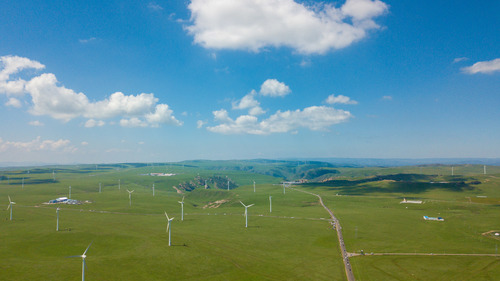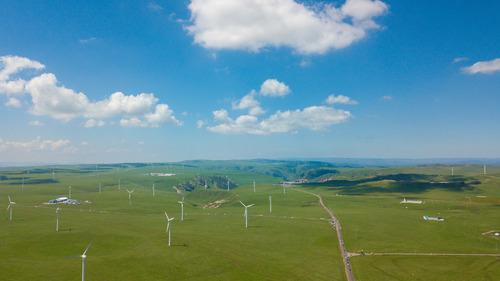
Aerial photo taken on Aug. 19, 2018 shows a wind power base in the city of Ulanqab, north China's Inner Mongolia Autonomous Region. (Xinhua/Peng Yuan)
BEIJING, April 1 (Xinhua) -- China is stepping closer towards building a national emissions trading system (ETS) with the revised version of interim regulations on carbon emissions trading management drafted by the country's ecology and environment ministry starting soliciting public opinions from March 30.
The national ETS is gradually taking shape with trading system undertaken by Shanghai and registration system by Hubei being under final adjustments and data docking. The national ETS is expected to be the world's largest carbon trading market when unveiled by end-June this year, according to Liu Jie, general manager of Shanghai Environment and Energy Exchange.
In the initial phase, 2,225 power firms that emit over 26,000 tonnes of greenhouse gases per year can start trading their emission quotas, according to the Ministry of Ecology and Environment (MEE).
-- Two-city structure taking shape
China's carbon trading market has seen rapid yet steady progress over the years and for the unfolding 14th Five-Year Plan (2021-2025) period, the system is expected to expand from single industry (power) to cover more industries, establishing a price signal for carbon to assist low-carbon transition country-wide and help fulfill China's commitment to peak carbon dioxide emissions by 2030 and achieve carbon neutrality by 2060.
In fact, the MEE has intensively issued a series of documents since last December covering matters such as the management measures upon carbon emission right trading, quota schemes, list of major emission companies, among others. It rolled out interim rules for carbon emissions trading managementwhich took effect from Feb. 1, a key step forward for the ETS.
The construction of the national ETS adopts such "two-city" model as Shanghai undertaking the trading system and Hubei's Wuhan the registration and settlement system, according to Liu Jie, noting that Shanghai and Hubei also undertake the establishment of respective carbon trading institutions and registration and settlement institutions.
So far 2,225 key emitters from power industry have completed account opening, according to a source with Hubei carbon trading center, noting that the registration system can provide services such as confirmation and registration of carbon emission rights, transaction settlement, among others. The national registration system in Hubei will gather a large amount of financial capital and industrial capital which could drive the rapid growth of Hubei's green finance and low-carbon industry, and help Hubei build a national carbon trading center and carbon financial center, the source noted.
Starting from power industry, a major carbon emitting sector, the national EST is to gradually expand coverage to other eight energy-consuming industries such as petroleum and chemical industries during 2021-2025 period, Liu Jie said.
-- National ETS and local pilots together
China has eight provinces and cities carrying out carbon emission trade piloting so far, seven of which were selected by the National Development and Reform Commission early in 2011 including Beijing, Tianjin, Shanghai, Chongqing, Hubei, Guangdong and Shenzhen. The eighth, Fujian carbon trading pilot was launched in 2016.
By November 2020, the cumulative trading volume of the pilot carbon markets is about 430 million tonnes of carbon dioxide equivalent, and the cumulative turnover amounted to nearly 10 billion yuan.
Due to inconsistent carbon market rules in different pilots and wide gap in carbon quota prices, a unified ETS is imminent.
According to trial rules published by the MEE, key emission companies included in the national ETS will no longer participate in the local carbon emission trading pilot market. And this raises question mark over how will local pilot markets develop in the future as the national ETS set to sail.
Shanghai-based power generation companies will be included in the national ETS, and the national market and local pilot markets will coexist, according to Liu Jie said, noting that although the national ETS will take part of the market away, existing pilots could continue their market-oriented trading activities as they cover broader scope of carbon trading entities.
In the meantime, those pilots are actively seeking reform, innovation and transformation while coordinating with the national market.
For example, besides carbon trading, Shanghai carbon market also engages in carbon finance, according to Liu Jie, noting that new explorations such as the introduction of quotas pledge, carbon fund, carbon trust, carbon forward products, among others, could provide lessons for the national ETS.
Beijing carbon trading pilot, after seven years' smooth operation since its launch in 2013, has basically formed complete system, standardized market, active trading, and strict supervision so far, according to Zhu Ge, chairman of China Beijing Green Exchange, noting that the exchange will actively promote the construction of a voluntary emission reduction trading platform and the development of green finance.
-- Top-level design plus market innovation
A national carbon trading market should be based on governmental top-level design and a top-down emission control approach, including unified market rules, clear monitoring of institutions at various levels, and unified accounting system, according to Professor Sun Chuanwang from China Energy Economic Research Center of Xiamen University.
Legislative system and management mechanism should be sped up, said Liu Jie, noting that for boosting market vitality, total quota and relevant allocation system should be reasonably determined. Meanwhile, market mechanism should be further improved including quota spot trading, diversifying trading varieties and methods, and expanding the scope of market entities.
A "total quantity control" mechanism could be promoted besides encouraging more participants to increase liquidity, giving full play to the financial function of the carbon market, Wang Yao, Dean of the International Institute of Green Finance of Central University of Finance and Economics, suggested.
In terms of carbon pricing, high-emission power and steel industries from which emissions account for 62 percent of the total, are more suitable for the ETS mechanism. For transportation and chemical industries, carbon tax pricing mechanism is more suitable, according to CICC chief economist Peng Wensheng, suggesting building a carbon market trading mechanism centered on "auction + futures", which means implementing an auction-based trading mechanism in the quota allocation, and introducing derivatives such as futures in the quota trade.
(Edited by Niu Huizhe with Xinhua Silk Road, niuhuizhe@xinhua.org)




 A single purchase
A single purchase









